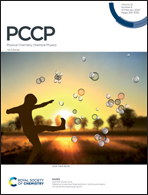Optimizing nitroxide biradicals for cross-effect MAS-DNP: the role of g-tensors’ distance†
Abstract
Nitroxide biradicals are common polarizing agents used to enhance the sensitivity of solid-state NMR experiments via Magic Angle Spinning Dynamic Nuclear Polarization (MAS-DNP). These biradicals are used to increase the polarization of protons through the cross-effect mechanism, which requires two unpaired electrons with a Larmor frequency difference greater than that of the protons. From their early conception, the relative orientation of the nitroxide rings has been identified as a critical factor determining their MAS-DNP performance. However, the MAS leads to a complex DNP mechanism with time dependent energy level anti-crossings making it difficult to pinpoint the role of relative g-tensor orientation. In this article, a single parameter called “g-tensors’ distance” is introduced to characterize the relative orientation's impact on the MAS-DNP field profiles. It is demonstrated for the first time how the g-tensors’ distance determines the nuclear hyperpolarization and depolarization properties of a given biradical. This provides a new critical parameter that paves the way for more efficient bis-nitroxides for MAS-DNP.



 Please wait while we load your content...
Please wait while we load your content...